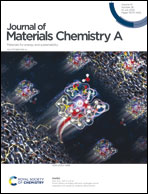Kinetic stabilization of a topotactically transformed texture morphology via doping in Ni-rich lithium layered oxides†
Abstract
Herein, a systematic investigation is conducted to unveil the role of phosphorus (P) or boron (B) doping in the development of a radially aligned textured microstructure during the synthesis of LiNi0.92Co0.04Mn0.04O2 (LNCM) layered oxides from the Ni0.92Co0.04Mn0.04(OH)2 (NCM) precursor. By comparatively examining the microstructure evolution in undoped, P-doped, and B-doped LNCMs and employing the state-of-the-art analysis techniques, it is revealed that the textured microstructure in P- or B-doped Ni-rich layered oxides is inherited from the hydroxide precursor morphology, and the P or B doping produces a lithium-containing amorphous oxide layer on the surface of primary particles, which acts as a kinetic barrier, delays the morphological transformation from textured to randomly oriented, and enables LNCMs to retain the textured morphology of the NCM precursor under optimized synthesis conditions. Our findings will guide a methodology to obtain the desired microstructure for Ni-rich layered oxides that can avoid crack formation/propagation and achieve long-term cycle stability.



 Please wait while we load your content...
Please wait while we load your content...